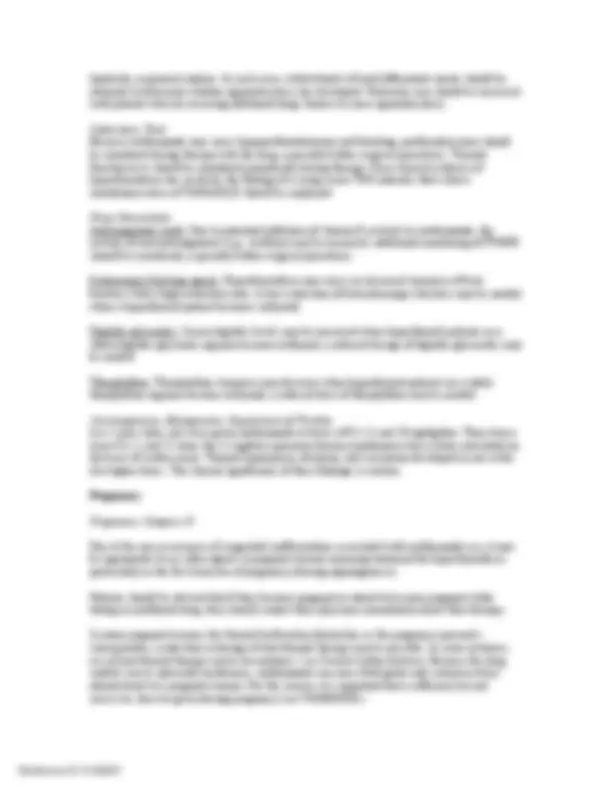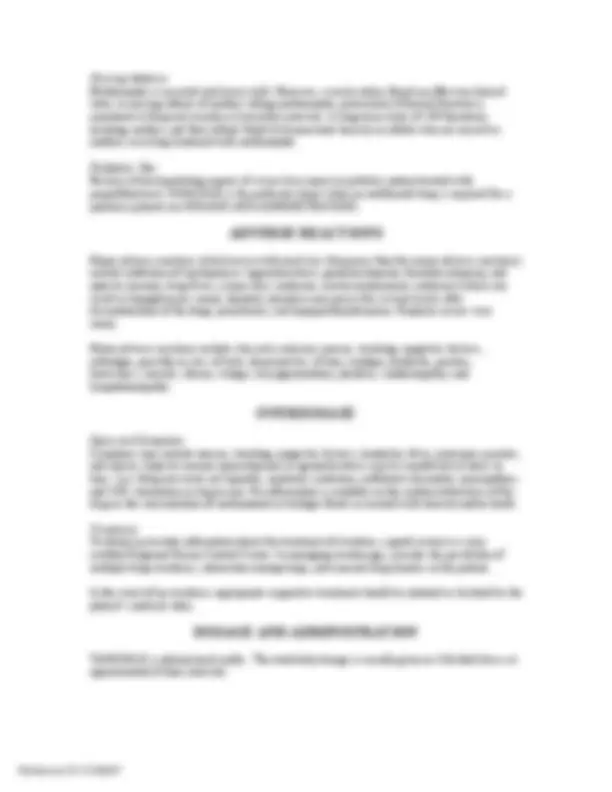





Study with the several resources on Docsity

Earn points by helping other students or get them with a premium plan


Prepare for your exams
Study with the several resources on Docsity

Earn points to download
Earn points by helping other students or get them with a premium plan
Community
Ask the community for help and clear up your study doubts
Discover the best universities in your country according to Docsity users
Free resources
Download our free guides on studying techniques, anxiety management strategies, and thesis advice from Docsity tutors
Detailed information about Methimazole, a white, crystalline substance used in the treatment of hyperthyroidism. It discusses the drug's clinical pharmacology, indications and usage, contraindications, warnings, precautions, and adverse reactions. Particular attention is given to the potential risks during pregnancy and breastfeeding, as well as drug interactions.
Typology: Lecture notes
1 / 5

This page cannot be seen from the preview
Don't miss anything!




®
TAPAZOLE®^ (Methimazole Tablets, USP) (1-methylimidazole-2-thiol) is a white, crystalline substance that is freely soluble in water. It differs chemically from the drugs of the thiouracil series primarily because it has a 5- instead of a 6-membered ring.
Each tablet contains 5 or 10 mg (43.8 or 87.6 μmol) methimazole, an orally administered antithyroid drug.
Each tablet also contains lactose monohydrate, magnesium stearate, starch (corn), pregelatinized starch and talc.
The molecular weight is 114.16, and the molecular formula is C4H 6 N2S. The structural formula is as follows:
Methimazole inhibits the synthesis of thyroid hormones and thus is effective in the treatment of hyperthyroidism. The drug does not inactivate existing thyroxine and tri-iodothyronine that are stored in the thyroid or circulating in the blood nor does it interfere with the effectiveness of thyroid hormones given by mouth or by injection.
Methimazole is readily absorbed in the gastrointestinal tract, metabolized in the liver, and excreted in the urine.
TAPAZOLE is indicated: In patients with Graves’ disease with hyperthyroidism or toxic multinodular goiter for whom surgery or radioactive iodine therapy is not an appropriate treatment option. To ameliorate symptoms of hyperthyroidism in preparation for thyroidectomy or radioactive iodine therapy.
TAPAZOLE is contraindicated in the presence of hypersensitivity to the drug or any of the other product components.
Congenital Malformations Methimazole readily crosses the placental membranes and can cause fetal harm, particularly when administered in the first trimester of pregnancy. Rare instances of congenital defects, including aplasia cutis, craniofacial malformations (facial dysmorphism; choanal atresia) and gastrointestinal malformations (esophageal atresia with or without tracheoesophageal fistula; umbilical abnormalities) have occurred in infants born to mothers who received TAPAZOLE during pregnancy. If TAPAZOLE is used during pregnancy or if the patient becomes pregnant while taking this drug, the patient should be warned of the potential hazard to the fetus.
Since the above congenital defects have been reported in offspring of patients treated with TAPAZOLE, it may be appropriate to use other agents in pregnant women requiring treatment for hyperthyroidism, particularly during organogenesis, in the first trimester of pregnancy. If TAPAZOLE is used, the lowest possible dose to control the maternal disease should be given.
Agranulocytosis Agranulocytosis is potentially a life-threatening adverse reaction of TAPAZOLE therapy. Patients should be instructed to immediately report to their physicians any symptoms suggestive of agranulocytosis, such as fever or sore throat. Leukopenia, thrombocytopenia, and aplastic anemia (pancytopenia) may also occur. The drug should be discontinued in the presence of agranulocytosis, aplastic anemia (pancytopenia), ANCA-positive vasculitis, hepatitis, or exfoliative dermatitis and the patient’s bone marrow indices should be monitored.
Liver Toxicity Although there have been reports of hepatotoxicity (including acute liver failure) associated with TAPAZOLE, the risk of hepatotoxicity appears to be less with methimazole than with propylthiouracil, especially in the pediatric population. Symptoms suggestive of hepatic dysfunction (anorexia, pruritis, right upper quadrant pain, etc.) should prompt evaluation of liver function (bilirubin, alkaline phosphatase) and hepatocellur integrity (ALT, AST). Drug treatment should be discontinued promptly in the event of clinically significant evidence of liver abnormality including hepatic transaminase values exceeding 3 times the upper limit of normal.
Hypothyroidism TAPAZOLE can cause hypothyroidism necessitating routine monitoring of TSH and free T levels with adjustments in dosing to maintain a euthyroid state. Because the drug readily crosses placental membranes, methimazole can cause fetal goiter and cretinism when administered to a pregnant woman. For this reason, it is important that a sufficient, but not excessive, dose be given during pregnancy (see PRECAUTIONS, Pregnancy).
General Patients who receive methimazole should be under close surveillance and should be cautioned to report immediately any evidence of illness, particularly sore throat, skin eruptions, fever,
Nursing Mothers Methimazole is excreted into breast milk. However, several studies found no effect on clinical status in nursing infants of mothers taking methimazole, particularly if thyroid function is monitored at frequent (weekly or biweekly) intervals. A long-term study of 139 thyrotoxic lactating mothers and their infants failed to demonstrate toxicity in infants who are nursed by mothers receiving treatment with methimazole.
Because of postmarketing reports of severe liver injury in pediatric patient treated with propylthiouracil, TAPAZOLE is the preferred choice when an antithyroid drug is required for a pediatric patient (see DOSAGE AND ADMINISTRATION).
Major adverse reactions (which occur with much less frequency than the minor adverse reactions) include inhibition of myelopoieses (agranulocytosis, granulocytopenia, thrombocytopenia, and aplastic anemia), drug fever, a lupus-like syndrome, insulin autoimmune syndrome (which can result in hypoglycemic coma), hepatitis (jaundice may persist for several weeks after discontinuation of the drug), periarteritis, and hypoprothrombinemia. Nephritis occurs very rarely.
Minor adverse reactions include skin rash, urticaria, nausea, vomiting, epigastric distress, arthralgia, paresthesia, loss of taste, abnormal loss of hair, myalgia, headache, pruritus, drowsiness, neuritis, edema, vertigo, skin pigmentation, jaundice, sialadenopathy, and lymphadenopathy.
Signs and Symptoms Symptoms may include nausea, vomiting, epigastric distress, headache, fever, joint pain, pruritus, and edema. Aplastic anemia (pancytopenia) or agranulocytosis may be manifested in hours to days. Less frequent events are hepatitis, nephrotic syndrome, exfoliative dermatitis, neuropathies, and CNS stimulation or depression. No information is available on the median lethal dose of the drug or the concentration of methimazole in biologic fluids associated with toxicity and/or death.
Treatment To obtain up-to-date information about the treatment of overdose, a good resource is your certified Regional Poison Control Center. In managing overdosage, consider the possibility of multiple drug overdoses, interaction among drugs, and unusual drug kinetics in the patient.
In the event of an overdose, appropriate supportive treatment should be initiated as dictated by the patient’s medical status.
TAPAZOLE is administered orally. The total daily dosage is usually given in 3 divided doses at approximately 8-hour intervals.
Adult -The initial daily dosage is 15 mg for mild hyperthyroidism, 30 to 40 mg for moderately severe hyperthyroidism, and 60 mg for severe hyperthyroidism, divided into 3 doses at 8-hour intervals. The maintenance dosage is 5 to 15 mg daily.
Pediatric - Initially, the daily dosage is 0.4 mg/kg of body weight divided into 3 doses and given at 8-hour intervals. The maintenance dosage is approximately 1/2 of the initial dose.
TAPAZOLE Tablets are available in: The 5-mg tablets are round, white to off-white, scored on one side and the other side debossed with “J94”. They are available as follows: Bottles of 100 NDC 60793-104-
The 10-mg tablets are round, white to off-white, scored on one side and the other side debossed with “J95”. They are available as follows: Bottles of 100 NDC 60793-105-
Store at controlled room temperature, 15° to 30°C (59° to 86°F).
Distributed by: King Pharmaceuticals, Inc. Bristol, TN 37620 Manufactured by: AAI Pharma, 1726 North 23rd St., Wilmington, NC 28405
Revised February 2012